|
Join Butterfly Conservation here and help us protect Sussex's amazing butterflies and moths |
NEW YEAR'S EVE 2011
An early afternoon walk around Pulborough Brooks RSPB Reserve produced two Brown Hairstreak eggs amongst the numerous Wigeon, Teal and other wildfowl. A Firecrest added some colour on route to West Mead Hide. (Mark Colvin)
Thursday 29 December 2011
A festive poke around in hamlet nettle beds up the Ouse valley yielded good numbers of overwintering Red Admiral caterpillars. Below one favourable South facing flint wall five were located in just under a metre's length, all much advanced in size compared with previous years (7mm+) (Dave Harris)
Tuesday 27 December 2011
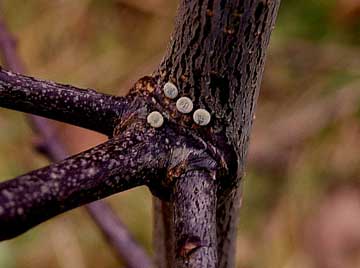
Members of Sussex BC put in a lot of work last winter mapping the Brown Hairstreak in Sussex (see Sussex BC 2010 Butterfly Report). I wanted to try and fill in some gaps and try to expand the boundaries of our already impressive distribution map. I was joined today by Richard Roebuck on a Brown Hairstreak egghunt in north-west sussex. Despite a lot of hunting along suitable habitat it would appear that this species does not extend much further here than our map already indicates. We were still able to plug a few gaps around Fernhurst though. Richard found an egg on a hedge which I had searched unsuccessfully in 2010 and, unusually, we found a blackthorn fork which contained four eggs (the eggs are almost always laid singly). For information on how to search for these eggs click on our atlas link above (Michael Blencowe & Richard Roebuck)
News for Thursday 22 December: I was very pleased to see a Red Admiral in flight in my garden on 22nd Dec. Very unexpected. (Colin Upton, Shoreham-by-Sea)
BOXING DAY 2011
I'm giving a talk on 'The Wildlife of Graffham Parish' on January 31st (Empire Hall, Graffham, 7.30pm) and noticed that there aren't any Brown Hairstreak records for the area. I solved that problem today by popping in to Graffham's local football field and found two Brown Hairstreak eggs on the blackthorn hedge almost immediately. It wasn't so easy further west in Heyshott though - I'd appreciate it if any members of the winter work parties at Heyshott could check the blackthorn next time they're in the area. (Michael Blencowe)
CHRISTMAS DAY 2011
Christmas Day is traditionally a time for getting out and crawling around in a blackthorn hedge in a muddy field in West Sussex. We headed out today to an area that we visited in the spring which had a 'promising' blackthorn hedge in it. There were plenty of suitable young suckers - and it was amazing how many leaves were still on the blackthorn. It didn't take long until we found some Brown Hairstreak eggs. After a short walk we located some more eggs along a sheltered field edge. Two new squares added to the Sussex Brown Hairstreak atlas and way more interesting than watching the Songs of Praise Christmas Special on the TV. (Michael & Clare Blencowe)
Thursday 22 December 2011
A Red Admiral flying around the Cedar at the junction of the main avenue and the road near Stansted House, W Sussex (SU754104) at about 1.30pm today. (Martin Hampton)
Red Admiral in my garden in East Wittering today (David Chainey)
A Red Admiral flying along Lewes High Street this afternoon amidst the tinsel and shoppers and basking in the warm afternoon sunshine. Happy Christmas folks! (Michael Blencowe)
It's 12 degrees in my garden in Coldwaltham on this sunny afternoon and a Red Admiral is fluttering around the Ivy growing up my wall - at 2:30 in the afternoon. It probably has been woken from hibernation by this amazing weather. (Chris Skinner)
Wednesday 21 December 2011
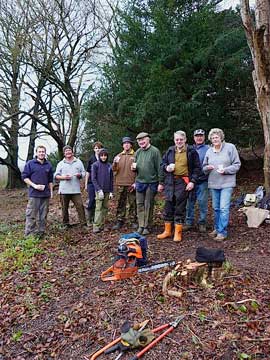
Today saw the last conservation work party at Heyshott before the Christmas break. We miss just one week and recommence activities on Wednesday, 4 January 2012. Despite a damp start the rain stayed away leaving a pleasant autumn day once more. Possibly tempted by the spicy aroma of hot mulled wine (some of us more so than others!) and mince pies, which added a seasonal touch to proceedings, ten people were on site today including John Murray, Mike Hadley and Sally Morris representing the Murray Downland Trust and James Colvin, Billy Lord, Neil Hulme, Roger Martin, Dan Hoare, Colin Knight and myself flying the flag for Butterfly Conservation at both local and national level. This was the eleventh scheduled work party at Heyshott Escarpment this winter and it was interesting to take time to stand back and reflect, on just how much a small and dedicated team of varying age and ability can achieve. I hope 'His Grace' appreciates the team's hard work (photo above). (Mark Colvin)
I would just like to report a 2nd Common Quaker to MV last night, 21/22 December. Another very early record. (Andy Adams)
Lindfield: I ran my moth trap last night for the first time in a couple of weeks. When I examined the catch this morning I was somewhat surprised to find a rather early Spring Usher and even more surprised by the presence of a very early (or late?) Double-striped Pug. However, on checking the records in the Sussex Moth Group website it appears December records for this species are not entirely unusual. The other species in the trap were a Winter Moth a Light Brown Apple Moth and 16 December Moths, the most I have ever caught in one night. (Bob Foreman)
Monday 19 December 2011
Sussex Butterfly Atlas records from end of September onwards:
25 September: TV5096A 1 Small Heath.
11 October: TQ2836A 1 Speckled Wood.
18 October: TQ2836A 1 Red Admiral.
20 October: TQ2636B 1 Speckled Wood.
22 October: SZ8496D 2 Red Admirals. SZ8696C 3 Red Admirals. SZ8694A 3 Red Admirals. SZ8694B 5 Red Admirals. SZ8694D 2 Red Admirals. 1 Speckled Wood.
23 October: TQ0416D 3 Red Admirals. TQ0416B 3 Red Admirals 1 Speckled Wood.
02 November: TQ2030A 1 Red Admiral.
13 November: TQ3230B 3 Red Admirals.
(Andrew Guest)
Thursday 15 December 2011
Arachnophobes should look away now...
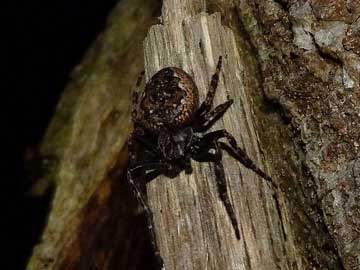
The work being undertaken at Heyshott Down is commendable for all involved however work precludes my attendance. I have to console myself with dog walking and the clash of darkness at this time of year.
However, nature is peculiarly quite active and the Winter Moths continue to be numerous going about their business in the woods. I have also seen mating pairs on silver birch, so they are quite cosmopolitan in their choice of potential egg laying sites.
As winter moths seem to be prolific, it's not quite the same for Brown Hairstreaks eggs which seem difficult to find in my local area of Henfield this winter. I digress. Apart from loads of Winter Moth this evening there seem to be plenty of beetles on oaks including mating pairs of an unidentified species around the roots of one oak tree. Most surprisingly I spotted three large spiders close to large open crevices on damaged oaks. Curious, I climbed an oak tree about 8 foot off the ground to get a pic. Now bearing in mind I did this in wellies (H and S forget it) and I was on the opposite side of a big trunk I was quite pleased with the pic. (no it wasn't taken in a zoo). I reckon it's a female Walnut Orb Weaver owing to the leaf like pattern on the abdomen. I haven't seen one before but apparently they live in cracks in trees and come out after dark, females are apparently active all year round so winter moths beware. (Richard Roebuck)
Somehow, this one got lost in the post: Tuesday 22 March 2011: A rather early Large White with Red Admirals and Small Tortoiseshells at Houndean Bottom, Lewes, in warm sunshine today. (Michael Hawkins)
Wednesday 14 December 2011
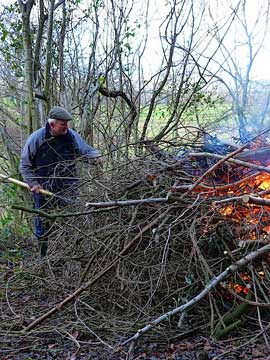
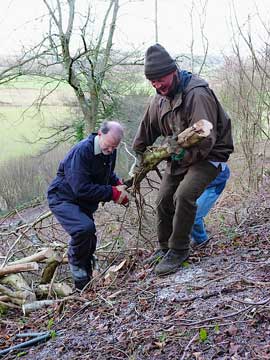
Today, along with Colin Knight and Neil Hulme and four members of the Murray Downland Trust, I continued my weekly work party season at Heyshott Escarpment. Despite the threat of early rain the sun burnt through leaving a beautiful autumn day. It was difficult to think of a better place to be. This is an extremely exciting project and one where positive management and hard work is continuing to improve the habitat for the Duke of Burgundy whose population appears to be doubling each year. The continued aim of the work, which has been ongoing for several years, is to create conservation corridors whereby linking strategically located habitats for the Duke of Burgundy, namely the exposed chalk workings higher up the reserve, down into the lower wooded areas below.
I thoroughly recommend attendance at these work parties and suggest that anyone with spare time on their hands on a Wednesday, should definitely come down and join us. A reasonable level of fitness is required as the slopes are steep and can be slippery. Bring hand-saws and loppers if you have them, though some tools will be available. Please remember the importance of gloves, strong footwear and eye protection. Roll on next week! (photos above). (Mark Colvin)
Tuesday 13 December 2011
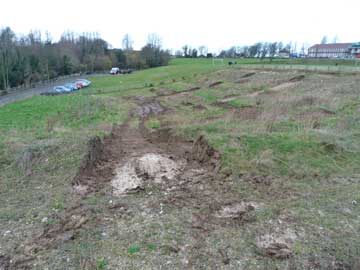
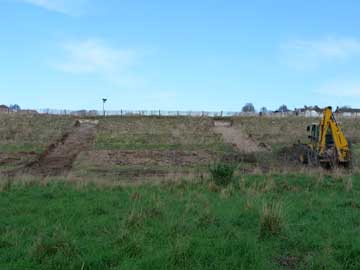
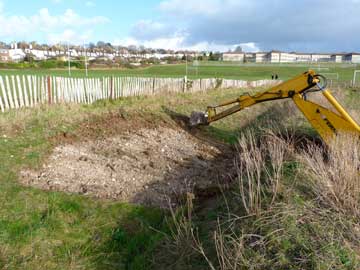
On Monday 12th and Tuesday 13th December 2011, Brighton & Hove Parks department kindly agreed to put a bulldozer at the disposal of Dorothy Stringer High School to help with the management of the butterfly haven. One of the problems associated with maintaining a site for early successional chalk grassland butterfly species is that the site needs to maintain early successional conditions, which in plain English means disturbance. This is particularly true for important species like the Small Blue that depends on kidney vetch, an early coloniser of bare chalk.
So I decided that we needed to expose more of the chalk on the site and thought the best way to do this was to create some new corridors in the existing static banks, perpendicular to the banks. Not only would this produce some disturbed ground but their creation resulted in new banks being created (using the spoil from the corridors). Furthermore, the machine operator (Gary Black) expertly produced some chalk scrapes at the top of the reserve to once again expose that all important bare chalk.
The resultant work is dramatic but I am keen to see consequences of this work next spring. Although we have disturbed the seed bank and could easily expect some opportunistic species colonising the site next year, my view is that in a couple of years the site will settle down and we could expect a greater diversity of species, as the essential range of successional habitats will have been extended even further.
Lastly, these corridors will also have created new access points for the visitor to the site, making a tour of the butterfly haven even more interesting.
Dorothy Stringer High School is very grateful to the Parks Department for this help and we are pleased to announce that they are now helping Varndean College develop their own butterfly haven, utilising the experience we have developed at the Liz Williams Butterfly Haven. There the plan is to sculpture curvilinear shapes into the bare chalk, producing multiple aspects and thus multivaried microclimatic conditions at ground level. We have discussed, 20m Crescent Moons and 30m Starfish. This work will also help inform Brighton & Hove on the development of more planned Butterfly Havens around the city.
Way to go, Brighton & Hove!
(Dan Danahar)
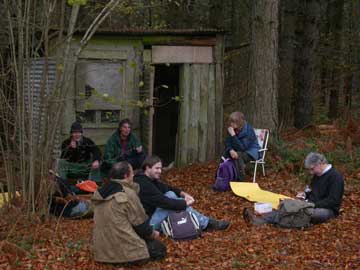
News for Sunday 11 December: The work party weather wasn't as good as it was in November - but that didn't stop our volunteers from turning up to Rowland Wood on Sunday - and it was good to see some new faces too. The work party task was to take down some birch to open up another new ride on our reserve which will act as a connecting corridor for butterflies and other wildlife as well as providing a flower-rich habitat. The team got to work with bowsaws and after a few hours had really improved the ride for wildlife. Thanks to everyone who attended; Dave M., Dave H., Colin, Roy, Nigel, Teresa, Roger, Gary and especially Keith. Keith's tub filled with his home made mince pies were certainly popular. In fact so popular that the two packets of mince pies I bought at the co-op were'nt even opened. Oh well, they wont go to waste. Next work party: January 8th. (Michael Blencowe)
Monday 12 December 2011
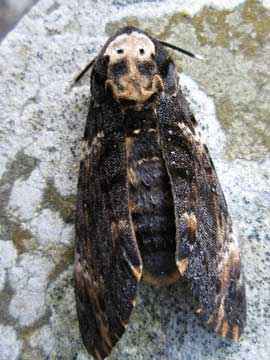
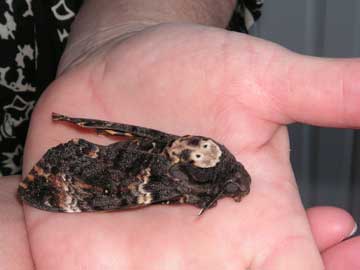
Death's-head Hawkmoth (above) found dead, in Summerdown Lane, East Dean, on our neighbour John Guy's lawn at first light this morning, it wasn't there at Sunset yesterday. (TV563985) (David & Carole Jode)
A Red Admiral flew past the window of the canteen at the University of Brighton Cockcroft Building (Moulscombe) at about 12:00 today. (Paul Flemming & Simon Rayburn)
Saturday 10 December 2011
Red Admiral enjoying the sun in our Shoreham garden. (Helen Corrigan)
Just had Red Admiral flying outside our house in North Portslade at 13.30. (Darryl Perry)
Wednesday 7 December 2011
Brought the washing in this afternoon and was hanging to dry off in the bathroom when out flew a Red Admiral which had obviously taken a fancy to my pink socks. (Keith Alexander)
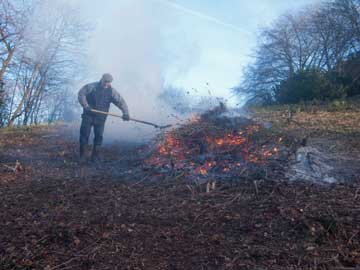
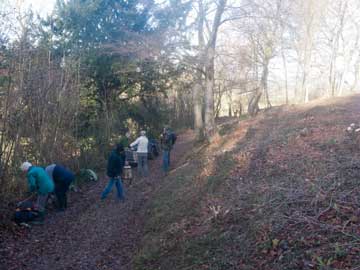
This morning I joined Murray Downland Trust volunteers again at Heyshott. I hope the Primulas appreciate three acres of downland reclaimed from the woods this season and make an appearance soon. We can then expect the endangered Dukes of Burgundy to flow down from the high ground. I recommend these Winter Wednesday morning sessions for wiping off the cobwebs and giving a great sense of satisfaction. If you would like to join us, you are welcome to contact me for details. (Colin Knight www.seapic.com)
Tuesday 6 December 2011
News for Sunday 4 December: Single Red Admiral around buildings at South Downs Heritage Centre, Hassocks. (Peter Whitcomb)
Jeremy Tatum's posting prompted a little "internal" debate over the identity of the moths in Richard's photo posted last Friday. Colin Pratt has now confirmed Jeremy's identification of the moths as Winter Moth. (ed.)
Monday 5 December 2011
Whilst working at Ditchling Common Country Park this afternoon, I found two Brown Hairstreak eggs and four Blue Bordered Carpet eggs on a small area of south-facing Blackthorn hedge. Grid reference: TQ333182. (Robin Bassett)
Recent (and not so recent) news:
20 September: Small Heath @ TQ359164.
2 October: Two Red Admirals @ TQ360165.
3 October: Speckled Wood @ TQ397179.
19 October: Speckled Wood,Red Admiral both @ TQ396178.
12 November: 2 Red Admirals @ TQ372136.
15 November: 4 Red Admirals @ TQ396178. Around fallen fruit.
2 December: Brown Hairstreak eggs @ TQ35411624, TQ35511627, TQ35571642, TQ35561640, TQ35541636.
(Jon Wood)
Sunday 4 December 2011
Hey, you copycats - you can't do that! I posted a female Winter Moth on our site in British Columbia (http://vicnhs.bc.ca/invertalert.html) on the very same day (December 02) that you did in Sussex! Do you think your moth might be a Winter Moth (Operophtera brumata)? I'm not familiar with your Scarce Umber, but your male sure looks like a Winter Moth, while your female looks rather darker than our female. The Winter Moth is not believed to be native out here, but it somehow made its way here from Europe. (Jeremy Tatum)
News for Friday 2 December: December and still butterflies on the wing! Saw a single Red Admiral in a garden in Robertsbridge on December 2nd. (Rob Bogue)
Saturday 3 December 2011
1 Pristine Red Admiral at midday Saturday on Oak leaves at Pulborough Brooks, looking brilliant in bright sunshine. (Anna Grist)
Whilst walking around the Knepp Castle Estate this afternoon, I found a Brown Hairstreak egg on a south-facing Blackthorn hedge. Grid reference: TQ148197. (Robin Bassett)
It was nice to see a Red Admiral flying round the garden in the afternoon sun here in Bexhill today. (Keith Alexander)
A lovely sunny morning, graced by a Red Admiral fluttering around the ivy that grows outside our bedroom window. This was at 10:15. (Chris Skinner)
Friday 2 December 2011
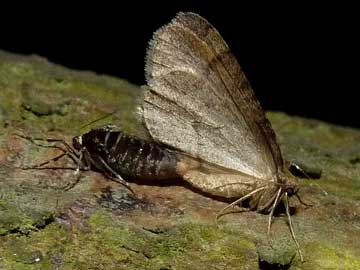
Recently I have seen a large number of weak flying moths in the car headlights just after dark on country lanes especially when it's been raining, but never really had time to stop. This evening at about 5.15 on a dog walk I was armed with my LED head torch and soon spotted my first moth. I then suddenly noticed several on a tree trunk with their wings back just like mayflies sit.
I then started looking at every oak tree I walked past and in all must have seen over 50 adult males. Some of the males I saw were just inflating their wings so I presumed these were emerging from chrysalises in bark crevices. Wondering why they were sat on the trunks I watched intently, eventually spotting a female with vestigial wings and then two more amongst other creatures like Opiliones and ground beetles and some rather odd slow moving large ants. I thought I would check out some other tree species and also found the moths on the leeward side of a field maple and finally a large sallow. On the sallow I found a mating pair (perhaps Scarce Umber?) (above). My camera phone was useless so dashed home and returned with my camera. It's the first time I have seen one of these types of curious female moths and of course the first time ever a mating pair. Fascinating stuff after dark. (Richard Roebuck)
At Cattlestone (near West Chiltington) this morning we were extremely surprised to see a Hummingbird Hawkmoth looking for somewhere to nectar! We have never seen one this late before. There was also a Red Admiral on the wing. (Chris and John Hamilton, Horsham)
A single Red Admiral still hanging on in my Edburton garden and yesterday a Migrant Hawker was my first ever December dragonfly. Also still a few moths around mostly December Moths, Sprawlers and Feathered Thorns. (Tony Wilson)
Lindfield: Had a single Red Admiral sunning itself on the kitchen windowsill this morning. (Bob Foreman)
Wednesday 30 November 2011
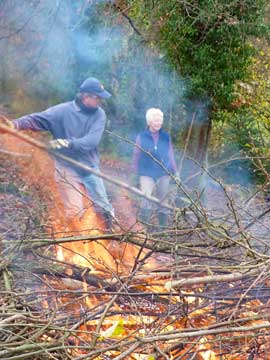
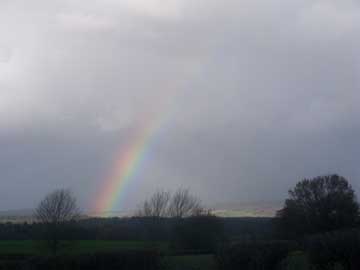
Mark and I joined Murray Conservation Trust members for more slash and burn at Heyshott Escarpment yesterday. A wonderful rainbow appeared as we walked off the hill. (Colin Knight www.seapic.com)
Tuesday 29 November 2011
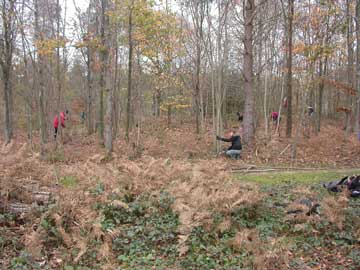
Thanks again to the hard working Brighton Conservation Volunteers. Their red minibus pulled up to Rowland Wood and a crowd of keen vounteers piled out, grabbed their bowsaws and got to work helping coppice trees, move logs and remove unwanted fencing on our reserve. Big thanks again to Mike Fearne and his crew. The BCV minibus levaes Brighton each week and heads out to sites across Sussex to help with conservation tasks. If you'd like to get involved check out their website: brightonconservationvolunteers.org
Sunday 27 November 2011
I would like to report the capture last night 26/27 Nov 2011 in my 125W mv moth trap here at Wadhurst a Common Quaker. These are normally Spring moths, more commonly seen from February to May. Also had a Spring Usher on the 19th Nov, more commonly seen in January. Getting to be quite a season. (Andy Adams)
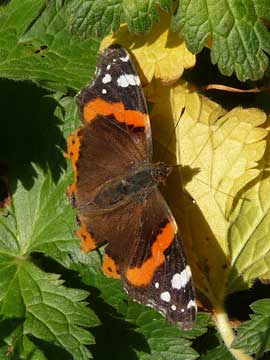
A rather tatty Red Admiral (above) spent much of the morning soaking up the late November sunshine in my Lindfield garden today. (Bob Foreman)
Crawley Down- just a single Red Admiral on the buddleia today, in very blustery conditions. It appeared to be in pristine condition. (Jonathan Ruff)
Friday 25 November 2011
Recent news: Two Red Admiral sightings around Arlington Reservoir (TQ532069 and TQ531070) late on Thursday morning 24th November 2011. (David Jode and Peter Coyston)
Sightings in our East Dean garden TV562984 - Wednesday 23rd November 2011 - 1 Red Admiral flying outside our conservatory around 1pm appeared to be looking for a roost. (David Jode)
Wednesday 23 November 2011
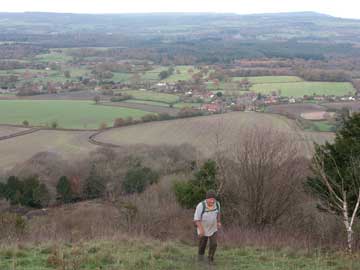
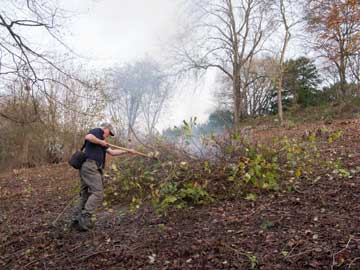
On Wednesday I joined Neil Hulme, Mark Colvin and Murray Downland Trust members for further work on the Heyshott Down Duke of Burgindy site. The cleared area is looking very impressive now. Afterwards we trekked to the top of the Down to enjoy the fabulous view (photos above). (Colin Knight www.seapic.com)
Saw a Red Admiral in my garden today (in Coldwaltham) and watched a Comma sunbathing on a tree trunk at Pulborough Brooks RSPB nature reserve on Sunday morning. (Chris Skinner)

News for Tuesday 22 November: The hard-working Brighton Conservation Volunteers (above) under the leadership of Mike Fearne visited our reserve this week. The work party meets in Brighton each tuesday and undertakes different tasks at a wide variety of locations in the in the area - and we've had our fair share of help from them in the past. This week they helped coppicing a ride near the pond and went to work with their usual enthusiasm. For more details about the group go to www.brightonconservationvolunteers.org. (Michael Blencowe)
Tuesday 22 November 2011
A Red Admiral in Durrington at lunchtime today (Tony Wilson)
Monday 21 November 2011
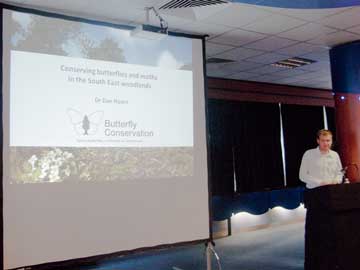
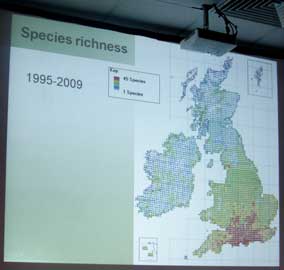
News from the weekend: Sue and I attended the BC AGM on Saturday at Cheltenham Racecourse and met up with Neil Hulme. We enjoyed the event very much and plan to attend next year's event on November 17, probably at Nottingham. Further details on my blog (Colin Knight www.seapic.com)
Sunday 20 November 2011
You probably have enough Red Admiral sightings (absolutely not! - ed.), but as this extraordinary November goes on I thought I would give you two more. We had a Red Admiral in our garden yesterday (19 Nov) and another today (20 Nov). (John Kerby)
Red Admiral in our Bexhill garden this afternoon. (Wendy & Keith Alexander)
I caught a really fresh looking Cypress Carpet in my porch last night. Quite an attractive moth - and I think an interesting record? (Mark Underhill)
Had the pleasure of watching a Red Admiral nectaring on ivy flowers in the garden in Lindfield this afternoon. (Bob Foreman)
Saturday 19 November 2011
A Red Admiral nectaring on ivy in my Ferring garden this afternoon. (Tim Freed)
Good to see a Red Admiral flying around in the sun in our front garden today in Barns Green at 11:30 a.m. It eventually landed on one of my boys toy tractors and bathed there in the sun until my 11 year old tried to get a picture and away it went. (John Coxon)
Crawley Down - just 2 Red Admirals in the garden today feeding for long periods on buddleia and, to a lesser extent, Viburnum. (Jonathan Ruff)
Still a Red Admiral today on the crab apples in my Edburton garden. A walk around the house after dark produced plenty of moths at the outside lights with the highlight being another Gem + Silver Y, 2 Rusty Dot Pearls, December Moth, 2 Winter Moths, Mottled Umber, Red Green Carpet, 2 Feathered Thorns and 2 Sprawlers. (Tony Wilson)
Thursday 17 November 2011
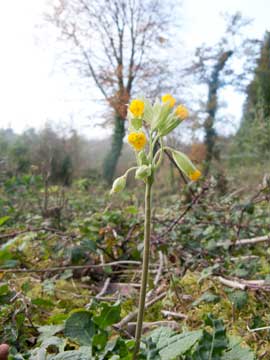
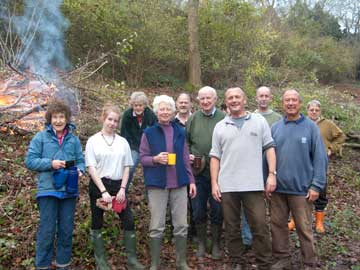
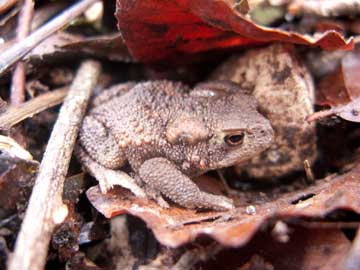
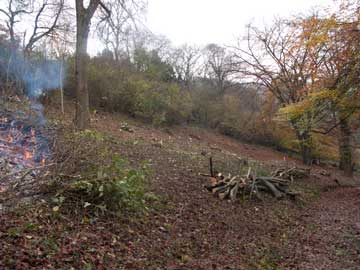
Yesterday Neil Hulme, Paul Day and myself joined members of the Murray Download Trust at Heyshott Escarpment. We continued with the creation of open corridors for the Duke of Burgundy to spread from its stronghold in the chalk pit area at the top of the down. A Trust member cut down the trees and we hauled them to the fire. It was steady but rewarding work as more slope was exposed for future colonisation by primulas, the Duke of Burgundy's foodplant.
We came across some toads which were moved lower down the slope. Later I joined Neil at Rewell Wood for some more clearance work on one of the rides where the small Duke of Burgundy colony is found. We found some Primulas in flower which is good news for the transplant programme. We then finished a tiring but satisfying day with sightings of a couple of Short-eared Owls and a Marsh Harrier at the nearby nature reserve. (Colin Knight www.seapic.com)
Wednesday 16 November 2011
Saw a Comma basking in the sunshine, on an oak tree, at Wiston today. (Richard Roebuck)
Tuesday 15 November 2011
I was at Goring by Sea station today and spotted a worn Red Admiral flying around some nettles. Curiosity got the better of me and thought it can't be. But oh yes, she was busy laying single blue green eggs on the top leaf surface of several short nettles - it was sunny but the air temperature was 12 degrees C. half an hr. later at West Worthing station I saw another Red Admiral and 3 common lizards basking in the sun. Has no one told these guys it's winter... (Richard Roebuck)
The record for the latest seen Red Admiral in our garden was broken by 2 days today at noon. Our slightly battered friend was so pleased to see me, that he/she briefly landed on my head twice. So I've brought him/her a few rotting apples from the shady end of the garden as a treat. (John Heys)
A Peacock on late-flowering honeysuckle in our garden today. (Derek Lee)
Spotted a Comma in my garden in Lindfield as I was idly gazing out of the kitchen window this morning. (Bob Foreman)
Monday 14 November 2011
News for Sunday 13 November:We saw 6 Red Admirals in our garden next to Holy Trinity Church, Cuckfield yesterday afternoon. They were sunbathing on the warm wooden wall of the garden room and lower branches of the oak tree.
They stayed for most of the afternoon displaying territorial behaviour to each other and the falling oak leaves! (Julie and Malcolm Redford)
Sunday 13 November 2011
It was a lovely calm and warm day yesterday at Park Corner Heath and Rowland Wood and the work party spent time in the sunshine clearing young birch from the plateau. We were also joined by Ben the Horse (Jack the Horse is having a rest) who helped drag logs for stacking. With such unseasonal warmth we hoped to see some butterflies and after we packed up the tools we went for a walk around our reserve and saw Red Admiral, Comma and three Brimstone (two females and a male). Thanks to everyone who attended; Lucy, Anna, Sherie, Roger, Roy, Bob, Colin, Dave, Nigel, Gary, Carlton, Marie, Ben (Horse), John, Peter, Keith, Peter. I can't promise such good weather next time! (Michael Blencowe)
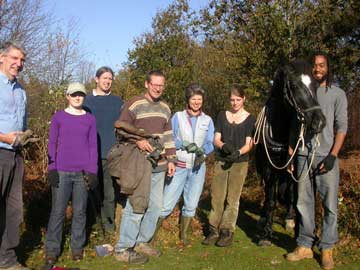

Two seperate Red Admirals at Brede High Wood this morning. Photo of the first one above (right). (Mike Mullis)
A Red Admiral was nectaring on Erysimum Bowles Mauve in my garden this morning and was still there in the early afternoon. (Stuart Ridley)
Painted Lady along the foreshore between Bracklesham and East Wittering. Also 4 Red Admirals on apples in our garden. (Derek Lee)
I spent the day watching my two sons play football in opposite ends of the county... One Red Admiral basking in warm sunshine in Wish Park, Hove (TQ270 050). (Caroline Clarke)
Crawley Down - on a perfect day for butterflies, (warm sun and no wind) at least 4 Red Admirals nectared for several hours on buddleia. Thats more than I saw on some days last summer! (Jonathan Ruff)
Not surprising given the warm sunny weather there was a Red Admiral on verbena and ivy in my Edburton garden today + a couple of late Bumble Bees and about 50 Harlequin ladybirds. (Tony Wilson)
It was very warm in our back garden in Hove this morning. We saw our local Red Admiral (equalling the latest date we've ever seen one here) and - a real surprise - a Speckled Wood. We do see them sometimes, usually in the dappled shade at the bottom of the garden, but never anywhere near this late in the year. It was not in a typical pose for a Speckled Wood - basking on the red brick at the back of the house. (John Heys)
Friday 11 November 2011
News for Thursday 10 November: Another two 'different' Red Admirals near the Burgh yesterday. When one considers just how exposed it is on the downland between Storrington and Amberley it interesting just how many butterflies can be located there. (Martin Kalaher)
Thursday 10 November 2011
Our back garden Red Admiral has come out again, 10 November, in its usual sheltered spot near some flowering ivy. The date is not a record for our garden - we saw single Red Admirals on 12 November 2008 and 13 November 2006, but it's getting close. (John Heys)
Wednesday 9 November 2011
Spotted a Red Admiral today on the banks of the river Arun in Littlehampton. (Celia Curtis)
One medium fresh Red Admiral circled our house in High Salvington at least five times at 11.15 this morning. It didn't seem interested in heading off to the south west but I had to go out so maybe it did eventually.
The Small Tortoiseshell which took up residence on a ceiling beam in our living room over the August Bank Holiday week-end is still there. (Peter Atkinson)
I know the season is well and truely over but just to say there was a very faded Red Admiral close to the 'Burgh', near Amberley. A couple of hundred yards further on from the first sighting there was a second butterfly but I was looking straight into a very low sun and was not able to ID.
Butterflies on the wing on 9th November is pretty good going. It will soon be spring!! (Martin Kalaher)
Tuesday 8 November 2011
Recent news: Sightings in our East Dean garden TV562984 - Saturday 5th November 2011 - 1 Red Admiral. (David Jode)
Saturday 5 November 2011
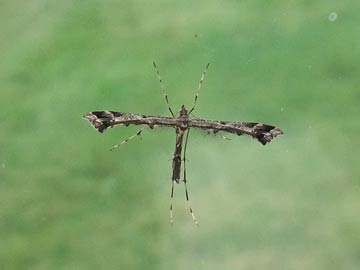
No more butterflies since 1 November, but yesterday (5 November) there was a rather nice plume moth (above) in our conservatory. It may have come in on the geraniums we've recently brought in from the garden. I helped it back outside as the spiders usually get anything that stays inside. I think we've had one in there before, but as my Collins "Complete British Insects" only has three plume moths, I gave up trying to identify it. Fortunately the moths UK website has over 30 plume moths, which is more useful. Having had a go, I think it may be Amblyptilia Punctidactyla (which is grey brown) rather than Amblyptilia Acanthadactyla (which is a warm reddish brown) despite the food plants for the latter being more favourable to mu garden. If anyone can confirm I'd be grateful. Shame these 2 species don't have "real" names - how about "cranesbill's cold cryptic plume" and "cranesbill's warm cryptic plume"? (John Heys, Hove)
At Edburton a Red Admiral was still feeding on crab apples. On the moth front a female Gem was still present from the day before and other moths over the last few days were Silver Y, up to 4 Rusty Dot Pearls, Cypress Carpet, Turnip, 4 Feathered Thorns, a few November Moths and a Sprawler. (Tony Wilson)
Thursday 3 November 2011
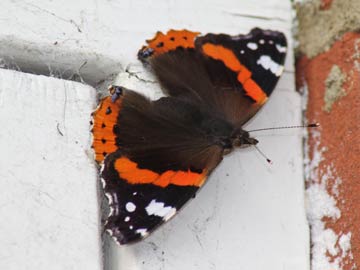
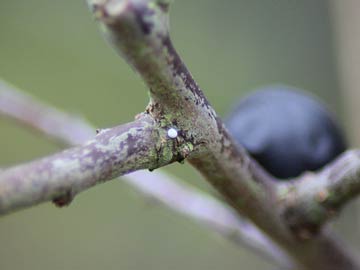
Recent news: I had a Red Admiral sunning itself in my Storrington garden on 1st November (above, left). Also, a Brown Hairstreak egg on Blackthorn (above, right). I found this about a week ago but it was too windy to attempt a photograph.
Mary and I have recently returned from a trip to Ontario where we were visiting family. The butterfly season there was more or less over but we did see approximately 10 species including a 'Gray Hairstreak'. The upper wings of this butterfly were an irridescent slate grey. Quite delightful! Anyway the reason for mentioning it is twofold; behaviour and parallel evolution. In North America there are just under 30 Hairstreak species and I was intrigued that in a different continent a similar shape of the rear wing had evolved. Watching this Gray Hairstreak gave me a very good clue. Every time it alighted on a fresh flower head it rubbed its rear wings 5-6 times before settling down to nectar. We watched it for 10 minutes or so and it repeated this behaviour without fail. The streamers of the rear wings were approximately one third of the length of the antennae but other than length they appeared to very similar in shape and colour pattern to the antennae. In other words they were 'false antennae' which together with the orange ring adjacent to the rear streamer might encourage a bird attack away from the head. I appreciate this is the case for the Peacock etc but I hadn't twigged that it might also be true for the Hairstreak group of butterflies. Other than that it really is a very beautiful butterfly! (Martin Kalaher)
Sightings in our East Dean garden TV562984 -
Tuesday 1 November 2011: - 2 Red Admiral (David Jode)
Monday 31 October 2011
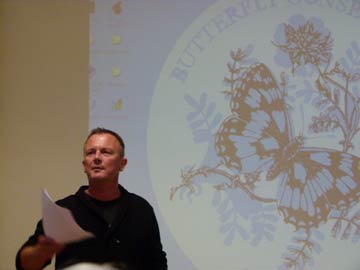
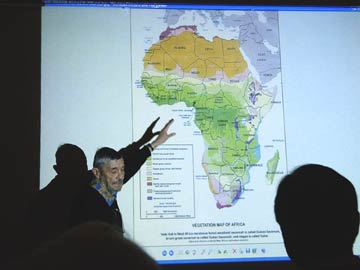
Seventy-seven people attended the Sussex Butterfly Conservation AGM at Beechwood Hall in Cooksbridge on Saturday. Chairman Neil Hulme rattled through the official AGM business and highlighted some of the achievements of the branch over the past year. The first speaker, international authority on butterflies Torben Larsen, gave a fascinating talk about butterfly diversity and conservation in Africa. The diversity of species in this region far outweighs our own but there are similar threats and Torben highlighted the losses of butterfly habitats over the past decades. During the break there was time to catch up with other members and the chance to chance your arm with our famous raffle. This year there were a number of prizes actually worth winning (thank you to all who donated prizes especially artist Valerie Baines who also had a stall at the event selling her beautiful wildlife illustrations www.valeriebaines.com and Mike Mullis who also had his wildlflower stall open for business). After the raffle Michael Blencowe presented his 60 minute review of 2011 and looked back over a year of 45 butterflies, some rare migrant moths, some sun, some rain and a giant, rotting ox liver. Finally Neil Hulme was presented with three bottles of the fizzy stuff (well, posh sparkling Sussex wines) in recognition of the incredible amount work he has dedicated to the branch in the role of chairman. Neil has now stepped down from the chairman role - though hopefully wont be straying too far. And after our members showed their appreciation for Neils work Mr Hulme officially drew the AGM to a close. Thankyou to all who attended. (photos above by Colin Knight)
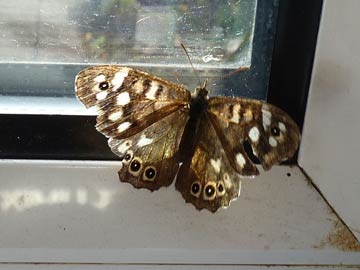
Neil said prepare for the unexpected and low and behold a worn but very active Speckled Wood arrived in the kitchen today (above), slightly off the beaten track I admit. But nevertheless my first November sighting for this species in the kitchen. In addition a pristine Painted Lady nectaring on valerian also seen today. (Richard Roebuck)
During a visit to Wakehurst Place today I saw 2 Red Admirals in the walled herbaceous garden both nectaring on Verbena bonariensis. There are still plenty of flowers on this lovely walled garden. (Stuart Ridley)
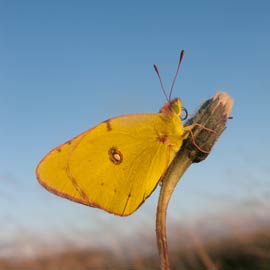
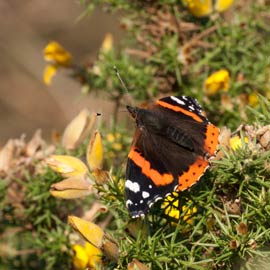
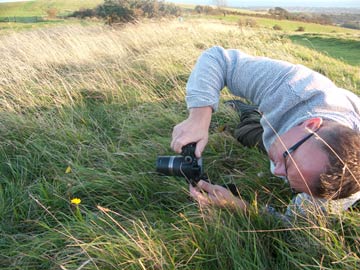
We walked round Cissbury Ring this afternoon. We found two Red Admirals on gorse then came across Neil with a beautiful male Clouded Yellow on the north east side. He shared his prize and my day was complete (photos above). (Colin Knight www.seapic.com)
Saw a Red Admiral inspecting nettels at Lewes station - presumably about to lay eggs. If it does lay eggs, I wonder how they long they will remain as eggs and larvae...? Any other recent observations of early stages of Red Admiral?
In Kingston near Lewes one Speckled Wood & one Red Admiral. Still a few dark bush crickets calling at night together with the Redwings flying over head. (Crispin Holloway)
On 29 Oct I saw a red admiral in our garden just before setting off for the AGM and I saw another in the field next to the hall in Cooksbridge, but it was going the wrong way for the meeting. I'm not usually able to get to the AGM so was very chuffed that Michael Blencowe used my picture of the weird small elephant hawk moth caterpillar, which he kindly attributed to me - but I have to stress that (as usual for exciting things) it was my wife that spotted it first! I've seen our garden Red Admiral again today [1 Nov], but it will have to stick around for another 3 days to beat our last Red Admiral garden sighting of 2010. (John Heys)
Saturday 29 October 2011
Crawley Down - 2 Red Admirals and 1 Small White on the Buddleia today. (Jonathan Ruff)
Friday 28 October 2011
Two Speckled Wood still on the wing at Thorney Island today, plus 3 Red Admirals and one Peacock. (Barry Collins)
Recent news: Hummingbird Hawkmoth sighted twice this October feeding from lavender in back garden, South Lancing, West Sussex, once early morning (0630), once at dusk (1715). (Alan Owen)
Thursday 27 October 2011
News for Tuesday 25 October: One Hummingbird Hawkmoth on honeysuckle in our back garden in Bavant Road, Brighton. (C and V Brooks)
Wednesday 26 October 2011
I spotted a rather active Speckled Wood on the Downs link this morning. Red Admirals continue to entertain around the garden not least from the fact that my wife thinks she has now bonded with Butterflies as a Red Admiral landed on her. On a slightly different note, Spindle trees are adorned with their characteristic pinkish fruits at the moment. Apparently in olden times these were ground up and used against lice. It did not specify which ones, so perhaps winter entertainment, on dark nights for those so infested (one for the pub quiz). (Richard Roebuck)
Recent news: Sightings in our East Dean garden TV562984 -
Monday 24th October 2011 - 1 Silver Y
Tuesday 25th October 2011 - 2 Red Admiral
(David Jode)
Monday 24 October 2011
Crawley Down, butterfly numbers on the rise again here, Red Admiral and Small White on buddleia in the sunshine, and Comma on Hebe. All looked in pristine condition, perhaps newly emerged. (Jonathan Ruff)
Sunday 23 October 2011
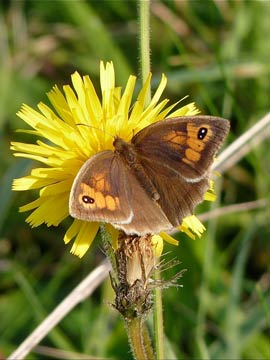
I visited Cissbury Ring this afternoon to hunt for the Clouded Yellows - which turned out to be wild geese! The photographic highlight of the trip was this remarkably fresh looking female Meadow Brown (above). I also saw a Speckled Wood and an incredibly battered Painted Lady. Later I bumped into Colin Knight and we had a brief chat about our highlights of the season. (John Williams)
Mill Hill - single Meadow Brown and a lovely wall just after 11am at Mill Hill before an irritating band of high cloud blocked out the sun! Used the shadow time to head over to Cissbury Ring hoping the sun would come out and a Clouded Yellow would appear. The cloud lasted longer than we hoped but eventually the sun did poke through and we saw at least 4 Meadow Browns, a couple of Speckled Woods and Red Admirals and also a Small Copper. Best of all we saw a yellow butterfly - but a lovely pristine male Brimstone not the Clouded Yellow. We consoled ourselves that a Brimstone in this condition is far more beautiful than a tatty migrant (or son/daughter of a tatty migrant).
Dashed back to Mill Hill in the late afternoon sun hoping for the Brown Argus and Common Blue we saw yesterday - alas no sign. (Chris and Ellie Corrigan)
On a dry, breezy overcast midday, three languid Meadow Brown Butterflies searched out nectar plants on the lower slopes of Mill Hill, one frequently returning to the one remaining Wild Basil seen. On the middle slopes, a Red Admiral landed on the path immediately south of the Copse on the top of the hill.
I have now browsed through the Mill Hill records and found that in most years one or two Brown Argus Butterflies are recorded in October on Mill Hill (but none in 2010) on several occasions. Large Whites are recorded in the month, but only a possible for November. A Speckled Wood was seen in Lancing on 22 October 2010. Speckled Woods are one of ten species seen in November. (Andy Horton, Adur Butterfly & Large Moth List)
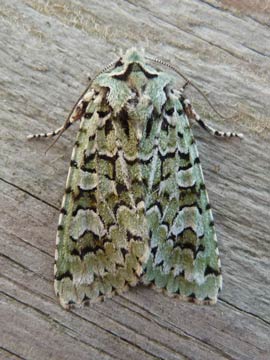
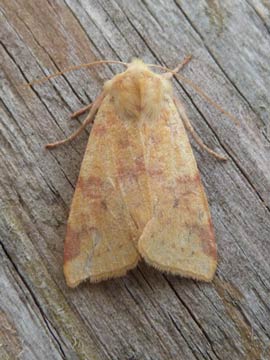
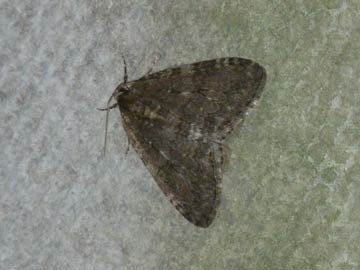
Photos from Mike Mullis (above) Merveille du Jour, Sallow and Pale November Moth, Herstmonceux, 22 October.
Recent news: Wednesday 19th whilst beating at Wiston saw a number of Red Admirals feeding on fallen rotten Pears, Monday 17th one Hummingbird Hawkmoth briefly visiting a Geranium at Saltdean. Over past few days numerous Red Admirals on the wing. Today at Plumpton on the downs a few Red Admirals flying by . But slightly unexpected a mint large white flying down the high street at Plumpton. (Richard Roebuck)
Saturday 22 October 2011
Mill Hill - singles of Common Blue, Brown Argus, Meadow Brown and Red Admiral on the lower slope. (Chris and Ellie Corrigan)
One Small Copper still on the wing at Thorney Island this morning, and a Speckled Wood in the church yard at Thorney yesterday. This afternoon I had a walk around Stansted Forest and had 9 Red Admirals. (Barry Collins)
Slopes above Butcher's Hole CP: one very worn Meadow Brown fluttering around and one fresh looking male Common Blue on a knapweed head - seemed too cold to fly! I was interested in the comment re migrating Red Admirals as I have seen a lot around during the past couple of weeks. There were still Speckled Woods dancing (fighting?) in Diplock's Woods yesterday. (Susan Suleski)
Friday 21 October 2011
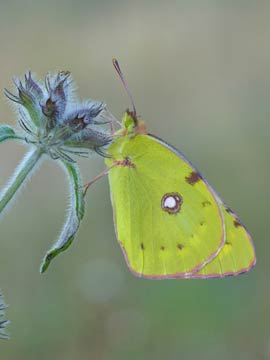
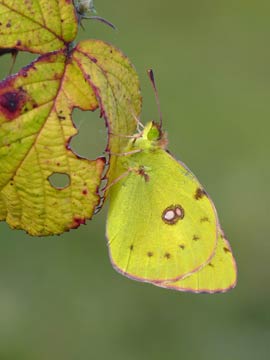
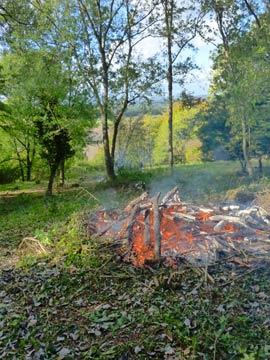
Recent news: Earlier this week I made several visits to Cissbury Ring where there are still a few Small Copper, Brown Argus, Speckled Wood, Meadow Brown, Peacock and emigrating Red Admiral to be seen. However, it was the Clouded Yellows (above) I was particularly interested in tracking down. Although this species is quite capable of arriving from mainland Europe in excellent condition, my gut feel is that these are the progeny of those butterflies which have been arriving steadily in low numbers since late July. With the recent drop in temperatures the flight window has been restricted to a couple of hours after midday, with the upside being that they can be followed until the weather puts them down. This coming weekend (particularly Sunday) should see them active if the forecasters are telling the truth. On Thursday (20th October), while at a meeting on Chantry Hill with rangers from the South Downs National Park Authority, we watched Red Admirals passing on the way to warmer climes at a rate of 6 per hour. The previous day saw the second work party of the season at Heyshott Escarpment. With John Murray and Mike Hadley (Murray Downland Trust) on chainsaws and BC Sussex members Paul Day, Mark Colvin and I doing the follow-up slash and burn (later joined by Tricia Murray and Rebecca) we cut a new habitat corridor which will hopefully allow Duke of Burgundy to spread further through the reserve and beyond. In reply to Chris Corrigan (see 17 October): yes, the Brown Argus you and Colin saw would be third brood specimens. There is undoubtedly a climate-related trend for some species to be squeezing in additional broods at the back end of the season. October has seen far more unusual events even than this, including second brood Duke of Burgundy and Ringlet in Hampshire! Expect the unexpected. (Neil Hulme)
Chris Corrigan has pointed out that I posted his Mill Hill report was from Sunday 16 October rather than Monday as it appeared. (ed)
Thursday 20 October 2011
It was too nice to be stuck indoors this afternoon so I had a walk through Seaford golf course to the track north of the course. I saw 8 Red Admirals, the majority basking in the sun, and 2 Speckled Woods, one in excellent condition and the other very faded and worn. (Stuart Ridley)
Wednesday 19 October 2011
Still 4 Small Coppers on the wing at the southern end of Thorney Island adjacent to Pilsey Sands, and several Red Admirals. (Barry Collins)
A downland walk centred around the 'Burgh' and Burpham revealed Small White (3), Red Admiral (2), Peacock (2) (haven't seen any of these for quite a while), Small Copper (1) and finally a very worn Painted Lady (1). For those interested in raptors, see my posting at the SOS website. (Martin and Mary Kalaher)
Tuesday 18 October 2011
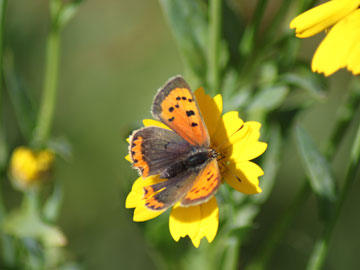
A Small Copper (above) was nectaring in my Storrington garden this morning. Also 5 Red Admirals seen on a short walk on the outskirts of the village. (Martin Kalaher)
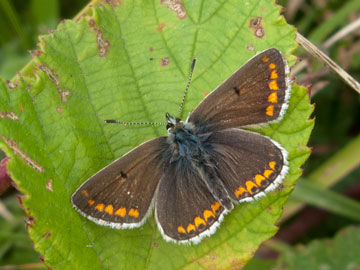
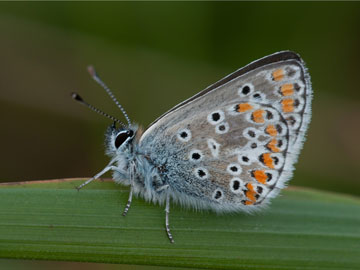

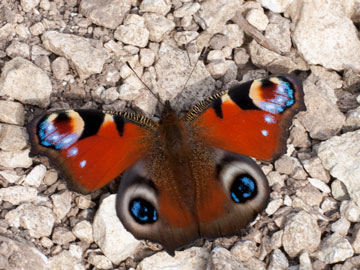
Recent news: Here are the pics that Chris requested (above). Mill Hill usually provides photo opportunities and Sunday was no exception. There were Common Blues and two Brown Argus at the foot of the hill, plus Red Admirals and Meadow Browns and a White. On Monday at Cissbury Ring I found a lovely Peacock and a worn Common Blue in the bowl below the north side, plus a Clouded Yellow in the ditch at the SW side. (Colin Knight www.seapic.com)
In answer to the query. Brown Argus have been seen on Mill Hill in October before. Numbers are variable form year to year and because of the at a glance confusion with the female Common Blue (which can be abundant) the exact prevalance is not known for certainty on Mill Hill. Large Whites have not been recorded in October locally, although a possible is noted. (Andy Horton, Adur Butterfly & Large Moth List)
Monday 17 October 2011
News for Sunday 16 October: Thanks to Colin Knight who was standing over an absolutely pristine Brown Argus - hopefully he will have some piccies for the website. Now I am more birds than butterflies but surely this must be a third brood individual tempted out by the Indian summer? Proper experts like Neil Hulme or Michael Blencowe will be able to say whether or not this is likely, or whether it is a common occurrence, or whether it is a ridiculous suggestion? We also saw a second Brown Argus scrapping with a Common Blue, 3 Meadow Browns and a Wall Brown. Sadly not the Clouded Yellow of the previous day. No doubt Colin may have other things to add. Glorious! (Chris Corrigan)
Hummingbird Hawkmoth once again at Keymer feeding at honeysuckle flowers. (Malcolm Le Grys)
News for Sunday 16 October: On Cissbury Ring I watched a very fresh-looking female Clouded Yellow in the ramparts on the SW corner. Elsewhere around the flanks I saw Peacock, Speckled Wood and a handful of Red Admiral heading south. (Neil Hulme)
News for the weekend: With the falling temperatures and a relative lack of nectar sources it is well worth searching ivy flowers for feeding moths from dusk onwards, as moths can be relatively simple to find there. At Church Norton on Saturday evening in cold temperatures my two traps caught only two moths, although they did manage to attract a couple of curious crabs. However, searching the ivy flowers produced a good list of species as follows: 4 Silver Y, 18 Brick, 3 Angle Shades and single Yellow-line Quaker, Green-brindled Crescent, L-album Wainscot, Chestnut, Dark Sword-grass, Sallow, Snout, Rush Veneer and Emmelina monodactyla.
One tip I have is to use a headtorch when searching for them, as the eye-shine can be very obvious even if the moth is not, and using a head torch rather than a conventional hand held torch gives you a far better chance of spotting the reflection. Another tip is to lightly tap the ivy flowers while placing a net or sheet beneath the flowers to catch the falling moths which are usually fairly docile for a few seconds giving you time to pot them. Happy hunting. (Dave Green)
Sunday 16 October 2011
I went for a walk on a gloriously hot day from Houghton Bridge along the south facing bank of the river Arun. I saw 15 plus Red Admirals nectaring on Ivy flowers, Speckled Wood 2, Comma 2, Peacock 1 and a feisty Painted Lady. I also took some time out to play with the exploding pods of the dastardly Himalayan Balsam that's colonising the damp areas. Had a quick look for some Brown Hairstreaks eggs in a likely spot but failed. TQ0111. (Richard Roebuck)
In the rides around Friston Forest today Red Admiral (10+), Brimstone (1 male), Meadow Brown (3), Silver-Y (1) (Michael & Clare Blencowe)
Saturday 15 October 2011
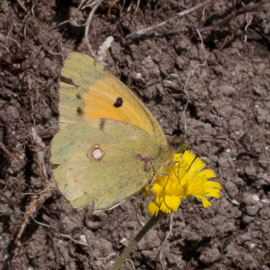
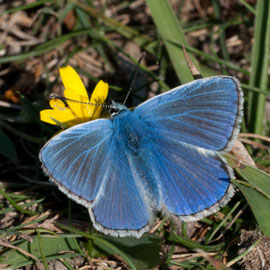
This afternoon I called in at Mill Hill and was rewarded with a Clouded Yellow which was patrolling across the whole of the hill. It was a bit tatty, but no matter it was my first of the year and made my day! There were also some Blues and Meadow Browns and a Red Admiral. I will return tomorrow hoping for more of the same. (Colin Knight www.seapic.com)
Nearing the end of the transect season notably fewer butterflies today. 25 individals of 5 species (Large White, Small Tortoiseshell, Small Copper, Speckled Wood and Red Admiral). 9 Admirals were observed migrating out to sea into a South - East breeze with two further females in a sheltered South facing spot heavily egg laying on old nettles between nectaring sessions on Ivy flowers. 16 degrees on the thermometer with Ring Ouzels and late House Martins keeping the twitchers happy. (Dave Harris)
News for Friday 14 October: A Hummingbird Hawkmoth was in my Edburton garden on 14th - the 35th day I've seen them in the garden this year + another was seen in Upper Beeding. Both were feeding on Valerian. (Tony Wilson)
Friday 14 October 2011
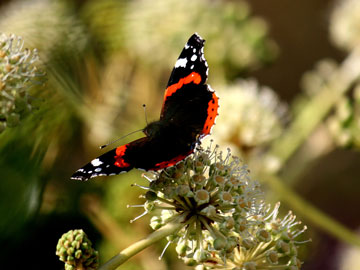
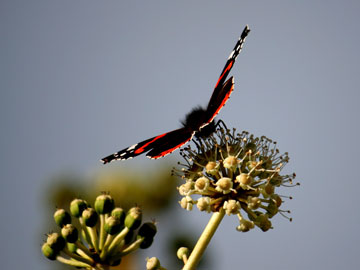
Last night was pretty cold and nothing much arrived in the moth trap. However this morning the sun soon warmed things up and the ivy flowers were covered in insects. But the highlight was 7 Red Admirals putting on a magnificent autumn display. Several were feeding on the flowers of a large Fatsia japonica. I couldn't resist taking some pictures as they looked spectacular against the creamy coloured flowers. It was slightly hazardous as I was stood on a chair at the time. (Richard Roebuck)
Hummingbird Hawkmoth continues to visit my Keymer garden, feeding from time to time during day at honeysuckle flowers. (Malcolm Le Grys)
At least five Red Admirals a Painted Lady, Speckled Wood and Large White in our Bexhill garden today. (Keith Alexander)
Whilst walking in Shipley this morning hoping to see some winter thrushes we noticed that Red Admirals are still migrating south. We counted at least 8 in about an hour. Obviously not as many as reported previously but definitely moving south in a determined fashion. (Chris & John Hamilton, Horsham)
Recent news: Yesterday (13th October) I made a short visit to Rewell Wood, seeing 4 Red Admiral, 2 Peacock and single Comma, Brimstone and Speckled Wood. A long walk over the Downs at Burpham this afternoon (14th October) was productive for both butterflies and birds. The mass exodus of Red Admirals through the Arun Valley is still underway, with a southerly movement at the observed rate of 12 per hour. Also seen were 9 Small White and 2 Clouded Yellow. Raptors included ringtail Hen Harrier (2), Red Kite (1), Buzzard (11), Sparrowhawk (2), Merlin (1) and Kestrel (4). (Neil Hulme)
Wednesday 12 October 2011
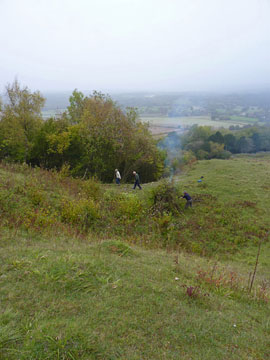
Work parties have now started in West Sussex too. This morning I joined John & Tricia Murray, Mike Edwards, Rebecca, Mike Hadley, Greg Wilson (Murray Downland Trust) and BC Sussex member Mark Colvin on the slopes of Heyshott Escarpment. Wednesdays won't suit everyone, but if you are available to help out this winter (see dates listed above) your assistance will be most appreciated. The ambitious 2011/2012 work programme will undoubtedly lead to a further improvement in the already healthy numbers of Duke of Burgundy, Dingy Skipper and other species here. Thanks to all who helped out today. (Neil Hulme)
Sightings whilst on the RSPB Eastbourne Group midweek walk from Birling Gap to Shooters' Bottom:
2 x Meadow Brown at TV562957
1 x Speckled Wood at TV561959
(David Jode)
Tuesday 11 October 2011
One Red Admiral was in Alciston village at 14.30 today. Also, one Hummingbird Hawkmoth was seen around Plumbago in our front garden in Bavant Road, Preston Park, Brighton, on the mornings of Saturday 8 and Sunday 9 October. (Colin Brooks)
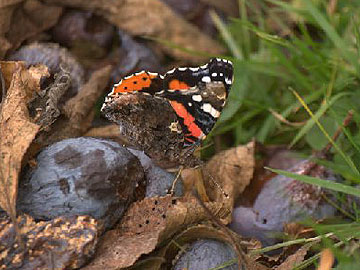
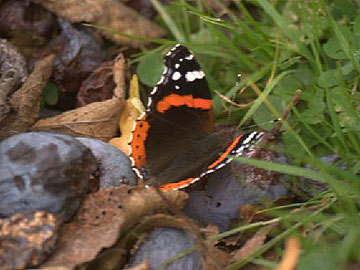
News for Monday 10 October: Red Admirals (above) gorging on fallen fermenting plums at Wiston, sharing with wasps (queens). Hard to say how many, 5-6 on floor lots up in the tree, can't see them unless they move. On floor they get so tipsy can nearly pick them up. (Tom Beach)
Monday 10 October 2011
A rather late Common Blue was in my garden in Edburton today along with a Peacock and 3 Red Admirals. A Comma was present yesterday. Both days an impressive Grass Snake has kept the children captivated keeping warm under a piece of roof felt (the snake that is, not the children). (Tony Wilson)
News for Sunday 9 October: A single Wall Brown butterfly in a sheltered spot at the north end of Mill Hill on Sunday. (Chris, Helen and Ellie Corrigan)
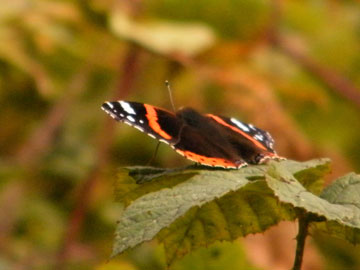
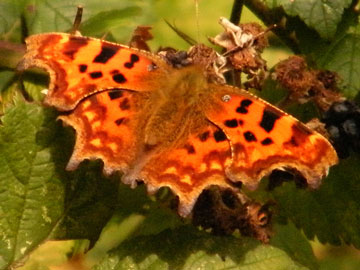
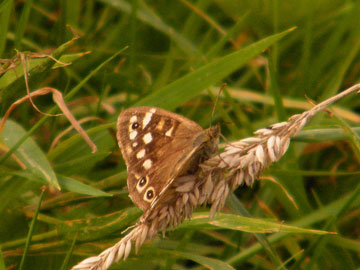
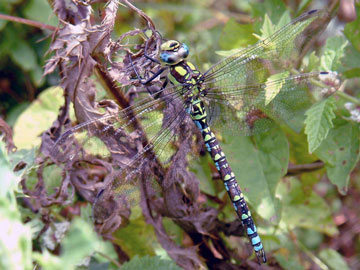
More news for Sunday 9 October: Sightings at RSPB Pulborough Brooks as follows Red Admiral 2, Comma 2, Speckled Wood 6, southern hawker 2, red darter 2. We had great day, I'm afraid the birds came second. (Pat and Peter Gardner)
Sunday 9 October 2011
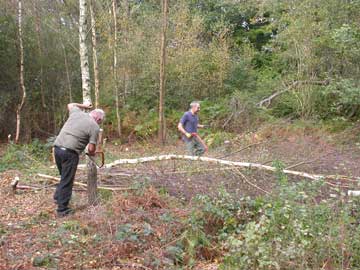
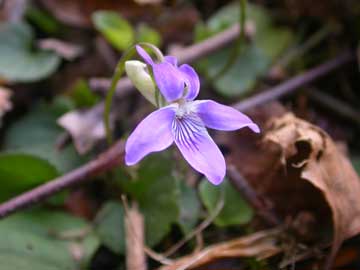
The first work party of the season. I dusted off the bowsaws and loppers (and some Jamaican Ginger Cake) and we headed to the western edge of Park Corner Heath to continue the coppice cycle and create a wider ride. Despite a damp start by mid-morning we were down to our t-shirts and enjoying more autumn sunshine. Speckled Woods, Red Admirals and a Peacock were flying and the violets were in bloom! Thanks to all who came along and helped out - Dave, Dave, Keith, Carole, Paul, Roy, John, Peter, Mike, Lucy, Vince and Graham. The next work party is on the second Sunday in November (November 13th) (Michael Blencowe)
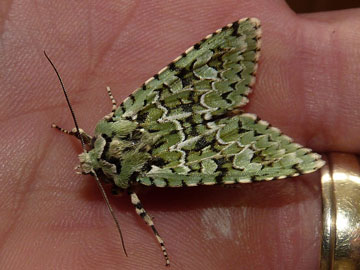
Last night was warm, overcast with periodic drizzle. A perfect night for moths with an interesting mix of pretty seasonal moths arriving at my MV trap. Including Pink-barred Sallow, Angle Shades, Silver Ys. But the best one was a beautiful Merveille du Jour (above). (Richard Roebuck)
Friday 7 October 2011
A pretty cold start today. However in the late afternoon sunshine yet another Hummingbird Hawkmoth flying briefly around the garden in Henfield.
My wife heard on the national news about the [Flame] Brocade moth and said you must put the moth trap on (interesting encouragement). After finally getting shot of a summer litter of delightful 9 springer spaniel pups, I can finally put the moth trap out again. So long as the one I kept doesn't eat it?? (Richard Roebuck)
Thursday 6 October 2011
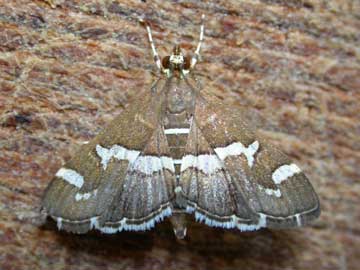
In our Bexhill garden on Wednesday were 3 Red Admirals and a Speckled Wood and in the moth box was a Hymenia recurvalis a rare pyralid from the tropics. (Keith Alexander)
For more news about migrant species in Sussex there is a very interesting story on the BBC website here.
Wednesday 5 October 2011
I would like to report that last night, 4/5 October 2011 I recorded my 2nd Clifden Nonpareil of the year. Here's to a few more. (Andy Adams)
Hummingbird Hawkmoth continues to visit my Keymer garden, feeding this morning at honeysuckle flowers. (Malcolm Le Grys)
It seems that no-one has yet named the Caterpillar bought from a 'wildlife shop' by one of Dan's ex-pupils and shown on your website on Oct 1. Surely it is a Death's-head Hawkmoth feeding on privet instead of potato (as in the UK Moths photo of the species)?
Just in case your moth-ers missed it there was a good story on the Hants BC website for Sep 24 describing the arrival of an adult moth of this species among sun bathers on Southsea beach - it read .."Sophie Venables reports from Southsea beach (SZ667985) where the following observations were made: 'Death's head' hawkmoth (1). "I am reporting this as it seemed such an unusual find - I've never seen one before and noticed its dramatic size and appearance. It appeared on the dark strap of a camera bag and was drawn to dark colours, including my young son's shorts, climbing up his leg to get to them which unnerved him rather!" (Ralph Hollins)
Tuesday 4 October 2011
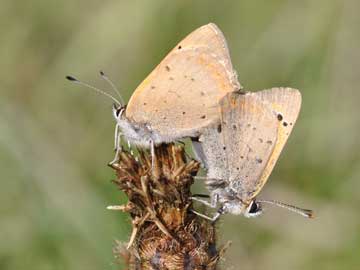
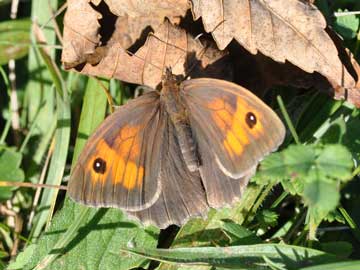
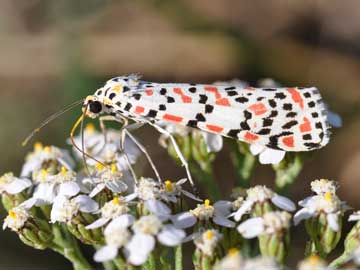
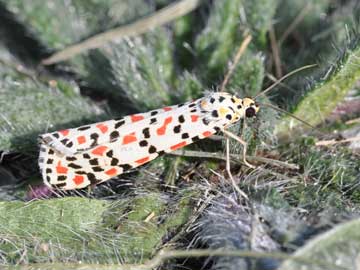
I decided today to have another attempt at seeing Clouded Yellow in the Beachy Head area, although with quite a breeze blowing I knew it would be unlikely that I would be successful. However, there were some butterflies flying with Small Heath, Speckled Wood, Meadow Brown, Comma, Small Copper, Red Admiral being seen. Then, at the furthest point a butterfly took off a few metres from me and was immediately taken by the wind. There was no doubt about it being a Clouded Yellow but goes down as the worst viewing I have ever had of one!! However, the star of the day was a moth. A white moth flew up from under my feet, I decided to have a closer look and was I glad I did as this moth was a spectacular Crimson Speckled. Unknown to me Michael Blencowe had trapped one in a nearby garden last night. Whether this was the same one is open to debate and perhaps with photos of the other one we may be able to check this out. At one point it landed on a flower and immediately started to nectar. Also seen was a mating pair of Small Copper and a very fresh Meadow Brown. 2 Adders were also seen (photos above). (Bob Eade)
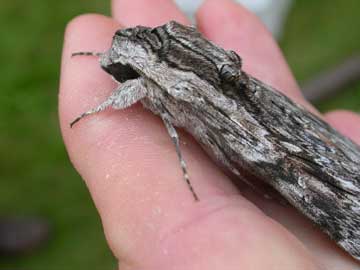
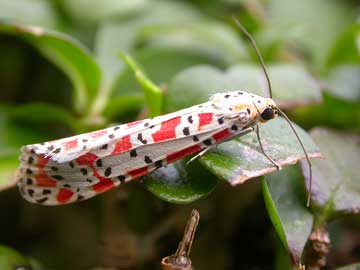
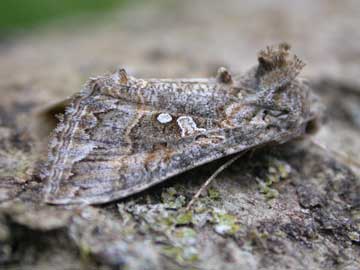
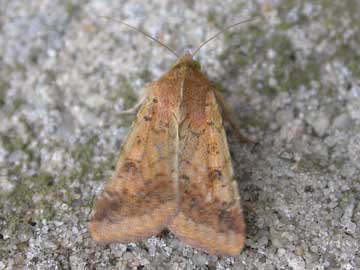
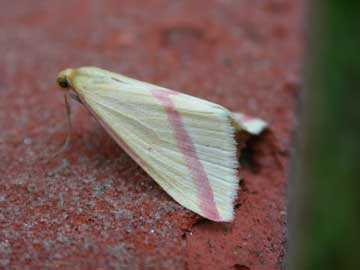
The conditions looked good for migrant moths on Monday night so with high hopes I fired up the traps at 7pm. In the morning I raced out of the house at 6:30 - I wasn't disappointed! Rusty Dot Pearl, Rush Veneer, Silver Y, Dark Sword Grass, Vestal, Ni Moth, Scarce Bordered Straw, Convolvulus Hawkmoth, Palpita vitrealis and (insert drum roll) a Crimson Speckled - which looked even more amazing than it does in the books! (photos above). For a full account of the moth action read Graeme's blog at href="http://analternativenaturalhistoryofsussex.blogspot.com/ (Michael Blencowe & Graeme Lyons)
Monday 3 October 2011
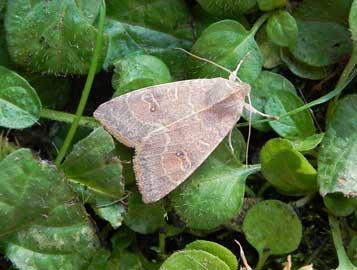
This Pale-lemon Sallow (above) was a nice surprise in the moth trap today at Heathfield. Nigel Kemp)
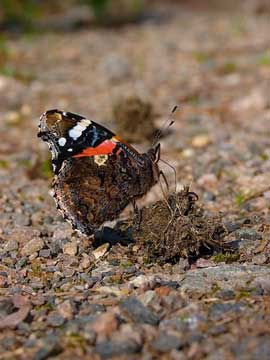
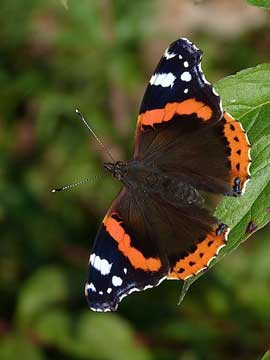
Red Admiral found in Chiddingfold Forest earlier today. At one point observed feeding on minerals and horse dung (photos above). (Mark Colvin)
Sunday 2 October 2011
Saturday night was a good night for migrant moth species here at Friston with Ni Moth (1) Diamond-back Moth (2) (my first for 2011), Scarce Bordered Straw (1) Delicate (1) Silver-Y (4) Dark Sword-grass (3) L-album Wainsot (2) recorded. Nearby torching attracted Flame Brocade. In South Malling (Lewes) on Sunday one Clouded Yellow was seen flying through the graveyard.(Michael Blencowe)
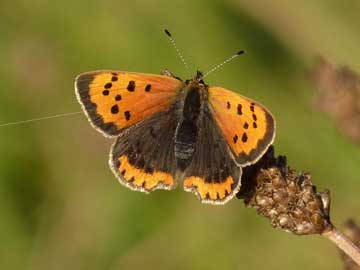

This may not be exactly ground breaking news but I was surprised to see a pristine Swallow-tailed Moth on Henfield library this afternoon. Apparently this could be a partial second brood emergence for this species, as we are in to October.
I think I had almost given up Butterflying this year but late this afternoon at Henfield I found 7 Red Admirals and two Commas nectaring on an ivy bush and in an old disused nursery a lovely Small Copper (above)and a pristine newly emerged male Common Blue. On the way home I was surprised to see a Laurel in flower, the last one I saw was in April with a Holly blue nectaring on it. (Richard Roebuck)
Hummingbird Hawkmoth in my Keymer garden this morning, feeding on the last remaining flowers of Viburnum bodnantense and dutch honeysuckle. (Malcolm Le Grys)
Four Clouded Yellows at Thorney Island today in a field south of the security gate west side. (Barry and Margaret Collins)
Saturday 1 October 2011
The large southward migration of Red Admirals is still underway. My father and I watched them moving down a valley at Burpham at the rate of 28 per hour this morning. (Neil Hulme)
Crawley Down - into October and a Hummingbird Hawkmoth is still visiting the garden regularly. (Jonathan Ruff)
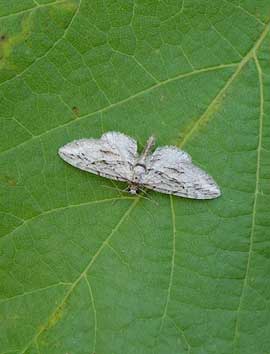
A specimen of the Cypress Pug (Eupithecia phoeniceata) found in my garden earlier this evening (photo above). (Mark Colvin)
Whilst on the Sussex Ornithological Society's walk from Birling Gap to Shooters' Bottom.
Single Clouded Yellow at
TV574956
TV576956
TV571957
TV569956
Single Painted Lady at TV562957.
Single Silver Y at TV568954
Also, continuing movement of Red Admiral out to sea.
Perhaps 10 each of Meadow Brown - Small Heath - Speckled Wood. A couple of - Small Copper - Common Blue plus one Small Skipper. (David Jode)
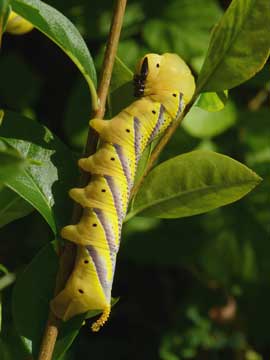
This caterpillar (above) was one of four that an ex-pupil brought in for me at school. He had purchased them from a livestock breeder, so sadly nothing wild caught to report here. However, I thought that people would like to see it. If you think you know the species, answers on a post card to... (Dan Danahar)
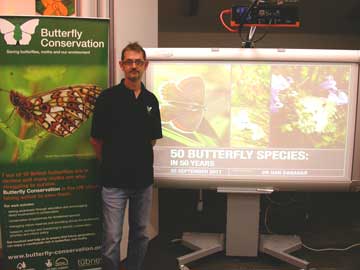
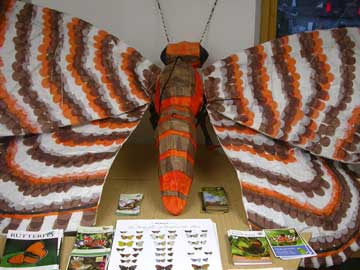
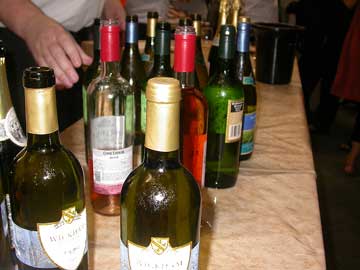
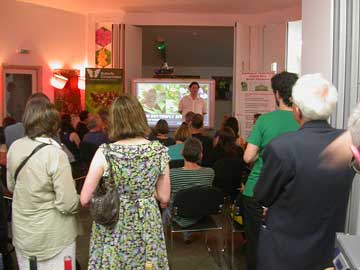
Over 60 thirsty lepidopterists gathered in the Linklater Pavilion last night for a wine tasting evening organised by branch fundraiser Carole Mortimer. Harveys brewery brewery hosted the event and there were a range of English wines to sample. We were all handed a guide to the wines on offer and, glasses in hand, we searched out a number of interesting wine species. It wasn't long until I had recorded quite a few wines - including Carr Taylor Rose, Nutbourne Bacchus, Nutbourne Sussex Reserve, Wickham Fume and Biddenden Gribble Bridge Dornfelder Red (which was hard to ask for after seven glasses of white). Harveys presented an informative talk on English Wines and our own Dr Dan Danahar then gave a talk on his experiences trying to find 50 butterfly species for his 50th year. Prizes were donated coutesy of Harveys and Bills in Lewes and were raffled. It was a fantastic evening; wine, butterflies, more wine and hundreds of pounds raised for Sussex BC. A big thank you to all those who came along and a huge thankyou to Carole for arranging a successful and enjoyable evening and another huge thankyou to Harveys for hosting the event and supporting Butterfly Conservation yet again. Make sure you support Harveys next time you visit your local pub! (Michael Blencowe)
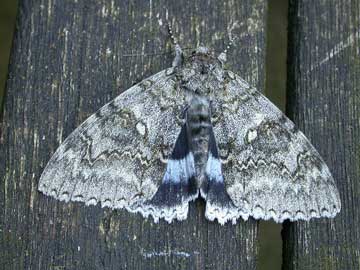
A Clifden Nonpareil (above) amongst the many Lunar Underwings in Bexhill last night. (Keith Alexander)